Innovative Capacitive Wireless Power System for Machines and Devices
Abstract
1. Introduction
2. Capacitive Coupler
3. Method for Selecting the Matching Circuits Parameters
- −
- Assumptions:
- f = 300 kHz (ω = 2π·f),
- XCM = 2639 Ω (CM = 201 pF),
- UO/UI = UR/UAC = 320/800 = 0.4 (accepted 0.5),
- k = 3.75.
- −
- Calculations:
- XC2 = 351.9 Ω (C2 = 1.51 nF)—(8),
- XC1 = 258.1 Ω (C1 = 2.06 nF)—(9),
- XL1 = XL2 = 351.9 Ω (L1 = L2 = 186.7 µH)—(6),
- XC1p = 88.0 Ω (C1p = 6.03 nF)—(5),
- XL1p = 88.0 Ω (L1p = 46.7 µH)—(4).
4. The System Model and Simulations
4.1. Simulation Model Setup
4.2. Key Findings from Simulations
4.3. Adjustments to Capacitance and Performance Impact
5. Laboratory Verification
6. In Situ Testing Facility
7. Initial Startup and Tuning the CWET System
8. Integration of the CWET System and the Drivetrain
8.1. Integration and Initial Testing
8.2. Stationary Measurements and Key Observations
- -
- η1 = PDC1/PAC·100%,
- -
- η2 = PDC23/PDC1·100%,
- -
- η3 = PDC23/PAC·100%,
- -
- η4 = Pout chrg/PDC23·100%,
- -
- η5 = Pout chrg/PDC1·100%,
- -
- η6 = Pout chrg/PAC·100%.
8.3. Dynamic Measurements and Key Observations
9. Conclusions
Author Contributions
Funding
- Scientific paper published as part of an international project co-financed by the European Commission Research Fund for Coal and Steel (RFCS) in the years 2020–2023; grant agreement no: 899469.

- Scientific paper published as part of an international project co-financed by the Ministry of Science and Higher Education’s program “PMW” in the years 2020–2023; contract no. 5117/FBWiS/2020/2.
- Scientific paper published as part of an international project co-financed by the Ministry of Science and Higher Education’s program “PMW” in the years 2020–2023; contract no. 5122/FBWiS/2020/2.
Data Availability Statement
Conflicts of Interest
References
- Dai, J.; Ludois, D. A survey of wireless power transfer and a critical comparison of inductive and capacitive coupling for small gap applications. IEEE Trans. Power Electron. 2015, 30, 6017–6029. [Google Scholar] [CrossRef]
- Lecluyse, C.; Minnaert, B.; Kleemann, M. A Review of the Current State of Technology of Capacitive Wireless Power Transfer. Energies 2021, 14, 5862. [Google Scholar] [CrossRef]
- Pahlavan, S.; Shooshtari, M.; Jafarabadi Ashtiani, S. Star-Shaped Coils in the Transmitter Array for Receiver Rotation Tolerance in Free-Moving Wireless Power Transfer Applications. Energies 2022, 15, 8643. [Google Scholar] [CrossRef]
- Detka, K.; Górecki, K. Wireless Power Transfer—A Review. Energies 2022, 15, 7236. [Google Scholar] [CrossRef]
- Luo, B.; Long, T.; Guo, L.; Dai, R.; Mai, R.; He, Z. Analysis and Design of Inductive and Capacitive Hybrid Wireless Power Transfer System for Railway Application. IEEE Trans. Ind. Appl. 2020, 56, 3034–3042. [Google Scholar] [CrossRef]
- Vincent, D.; Huynh, P.S.; Williamson, S.S. A Link-Independent Hybrid Inductive and Capacitive Wireless Power Transfer System for Autonomous Mobility. IEEE J. Emerg. Sel. Top. Ind. Electron. 2022, 3, 211–218. [Google Scholar] [CrossRef]
- Karagozler, M.E.; Goldstein, S.C.; Ricketts, D.S. Analysis and modeling of capacitive power transfer in microsystems. IEEE Trans. Circuit Syst. I 2012, 59, 1557–1566. [Google Scholar] [CrossRef]
- Hui SY, R.; Ho WW, C. A new generation of universal contactless battery charging platform for portable consumer electronic equipment. IEEE Trans. Power Electron. 2005, 20, 620–627. [Google Scholar]
- Kaczmarczyk, Z.; Kasprzak, M.; Ruszczyk, A.; Sowa, K.; Zimoch, P.; Przybyła, K.; Kierepka, K. Inductive Power Transfer Subsystem for Integrated Motor Drive. Energies 2021, 14, 1412. [Google Scholar] [CrossRef]
- Hu, A.P.; Liu, C.; Li, H.L. A Novel Contactless Battery Charging System for Soccer Playing Robot. In Proceedings of the 15th International Conference on Mechatronics and Machine Vision in Practice, Auckland, New Zealand, 2–4 December 2008; pp. 646–650. [Google Scholar]
- Lu, F.; Zhang, H.; Hofmann, H.; Mi, C. A double-sided LCLC-compensated capacitive power transfer system for electric vehicle charging. IEEE Trans. Power Electron. 2015, 30, 6011–6014. [Google Scholar] [CrossRef]
- Zhang, H.; Lu, F.; Hofmann, H.; Liu, W.; Mi, C. A four-plate compact capacitive coupler design and LCL-compensated topology for capacitive power transfer in electric vehicle charging application. IEEE Trans. Power Electron. 2016, 31, 8541–8551. [Google Scholar]
- Lu, F.; Zhang, H.; Mi, C. A two-plate capacitive wireless power transfer system for electric vehicle charging applications. IEEE Trans. Power Electron. 2018, 33, 964–969. [Google Scholar] [CrossRef]
- Sinha, S.; Kumar, A.; Regensburger, B.; Afridi, K.K. A new design approach to mitigating the effect of parasitics in capacitive wireless power transfer systems for electric vehicle charging. IEEE Trans. Transp. Electrific. 2019, 5, 1040–1059. [Google Scholar] [CrossRef]
- Vu, V.-B.; Dahidah, M.; Pickert, V.; Phan, V.-T. An Improved LCL-L Compensation Topology for Capacitive Power Transfer in Electric Vehicle Charging. IEEE Access 2020, 8, 27757–27768. [Google Scholar] [CrossRef]
- Panchal, C.; Stegen, S.; Lu, J. Review of static and dynamic wireless electric vehicle charging system. Eng. Sci. Technol., Int. J. 2018, 21, 922–937. [Google Scholar] [CrossRef]
- Deja, P.; Skóra, M.; Stankiewicz, K.; Tokarczyk, J.; Kasprzak, M.; Kaczmarczyk, Z.; Hildebrandt, R. Wireless energy transfer system for use in underground mining. Acta Montan. Slovaca 2022, 27, 267–280. [Google Scholar]
- Erel, M.Z.; Bayindir, K.C.; Aydemir, M.T.; Chaudhary, S.K.; Guerrero, J.M. A comprehensive review on wireless capacitive power transfer technology: Fundamentals and applications. IEEE Access 2022, 10, 3116–3143. [Google Scholar] [CrossRef]
- Gierlotka, S. Elektropatologia porażenia prądem elektrycznym oraz bezpieczeństwo przy urządzeniach elektrycznych (Electropathology of electric shock and the safety of using electrical equipment). In Zeszyty dla Elektryków; Booklets for Electricians—No. 12; Grupa Medium: Warsaw, Poland, 2015; ISBN 978-83-64094-43-9. [Google Scholar]
- Lu, F.; Zhang, H.; Hofmann, H.; Mi, C. A double-sided LC-compensation circuit for loosely coupled capacitive power transfer. IEEE Trans. Power Electron. 2018, 33, 1633–1643. [Google Scholar] [CrossRef]
- Kaczmarczyk, Z.; Kasprzak, M.; Lasek, P.; Przybyła, K.; Skóra, M.; Stankiewicz, K. Realizacja systemu bezprzewodowego przesyła energii na zasadzie sprzężenia pojemnościowego/Implementation of a wireless energy transfer system based on capacitive coupling. In Proceedings of the 16th Conference Control in Power Electronics and Electric Drives—“SENE 2023”, Łódź, Poland, 22–24 November 2023. [Google Scholar]
- Pytlik, A.; Hildebrandt, R.; Stankiewicz, K.; Skóra, M. Suspended mining monorail composite-steel rail resistance to static and fatigue loads. Arch. Min. Sci. 2024, 69, 509–528. [Google Scholar] [CrossRef]

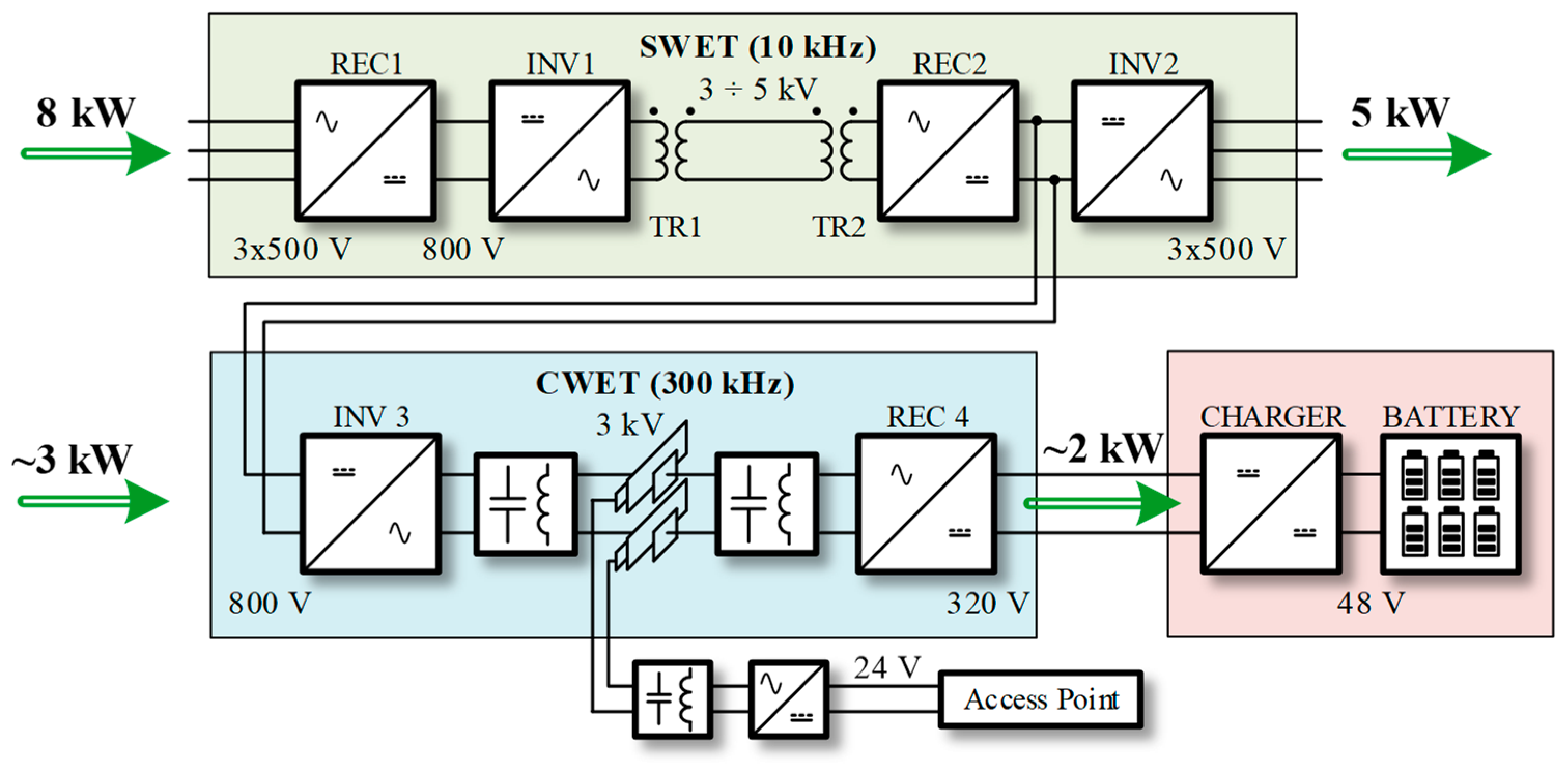
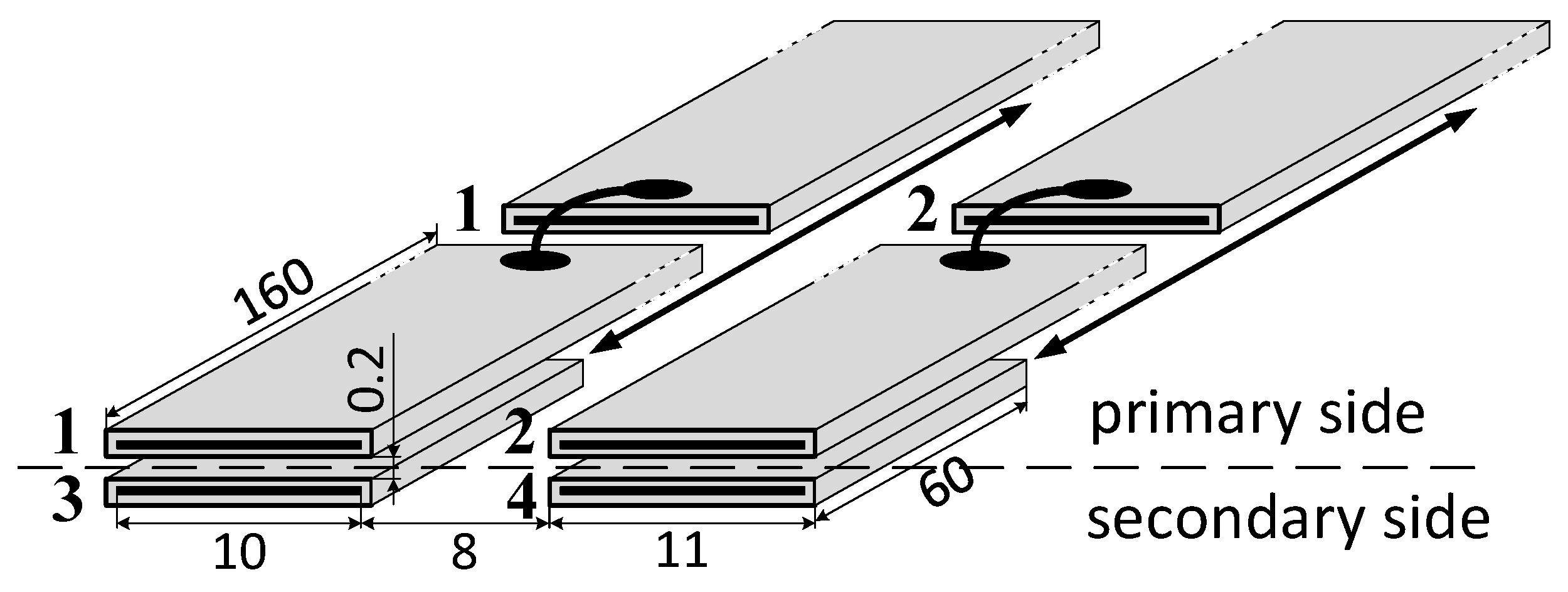
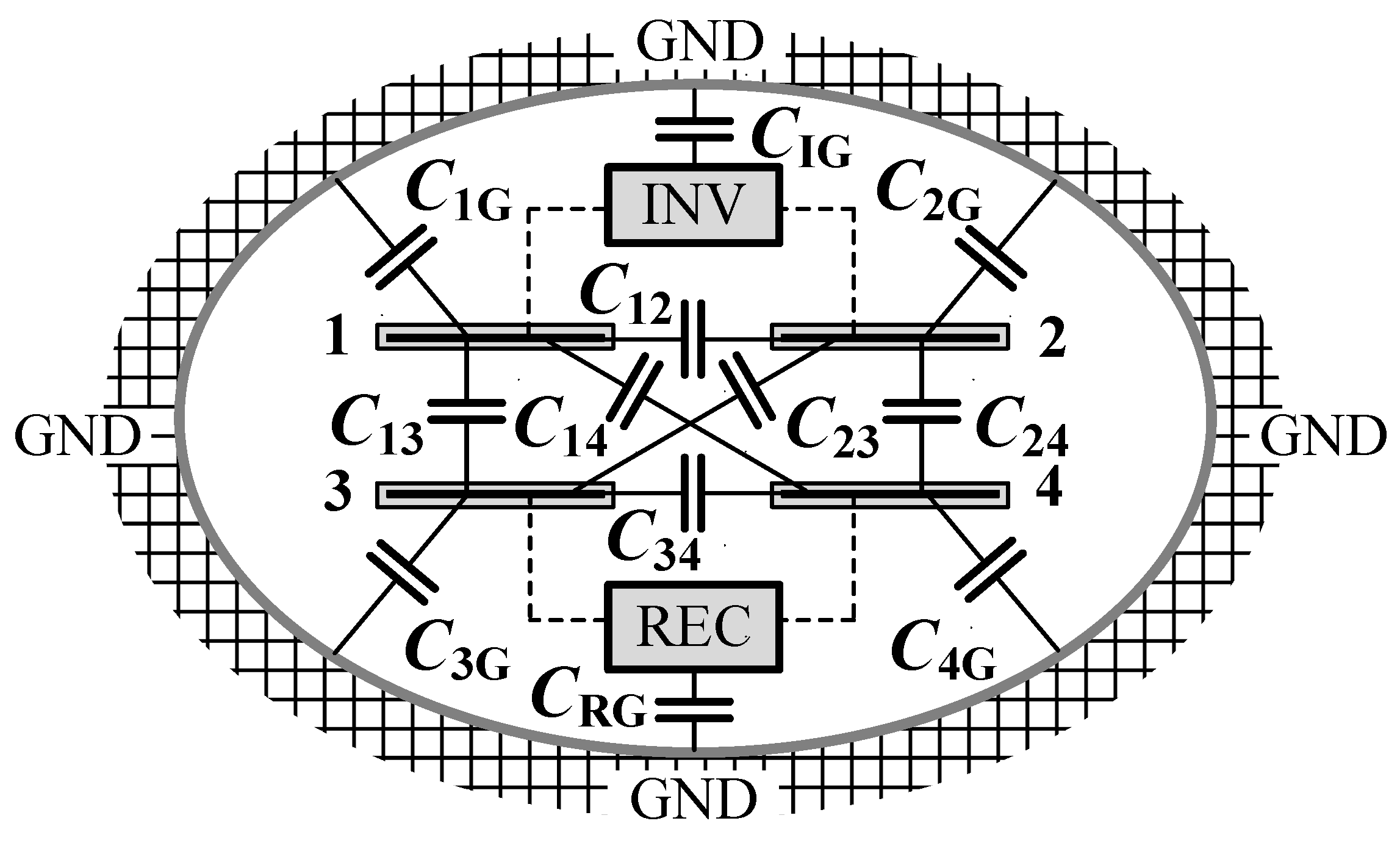




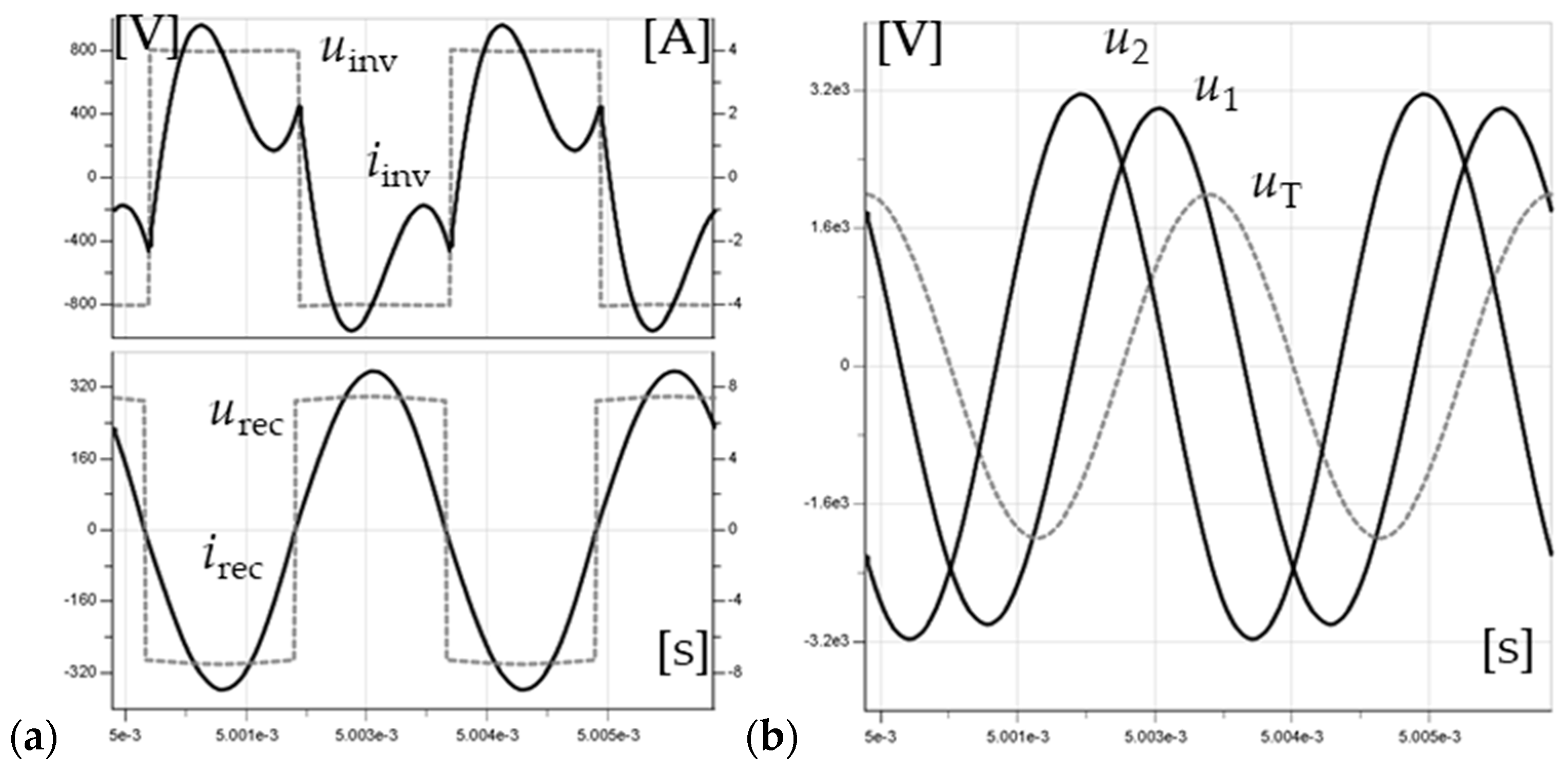


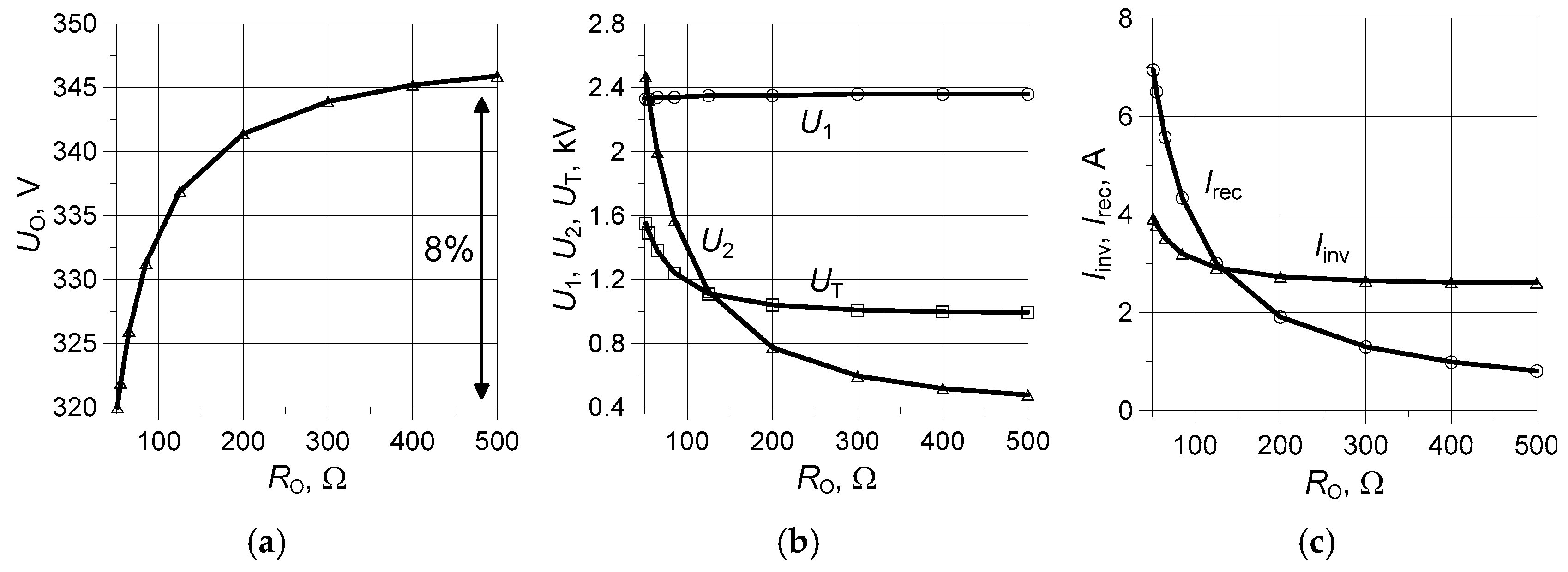
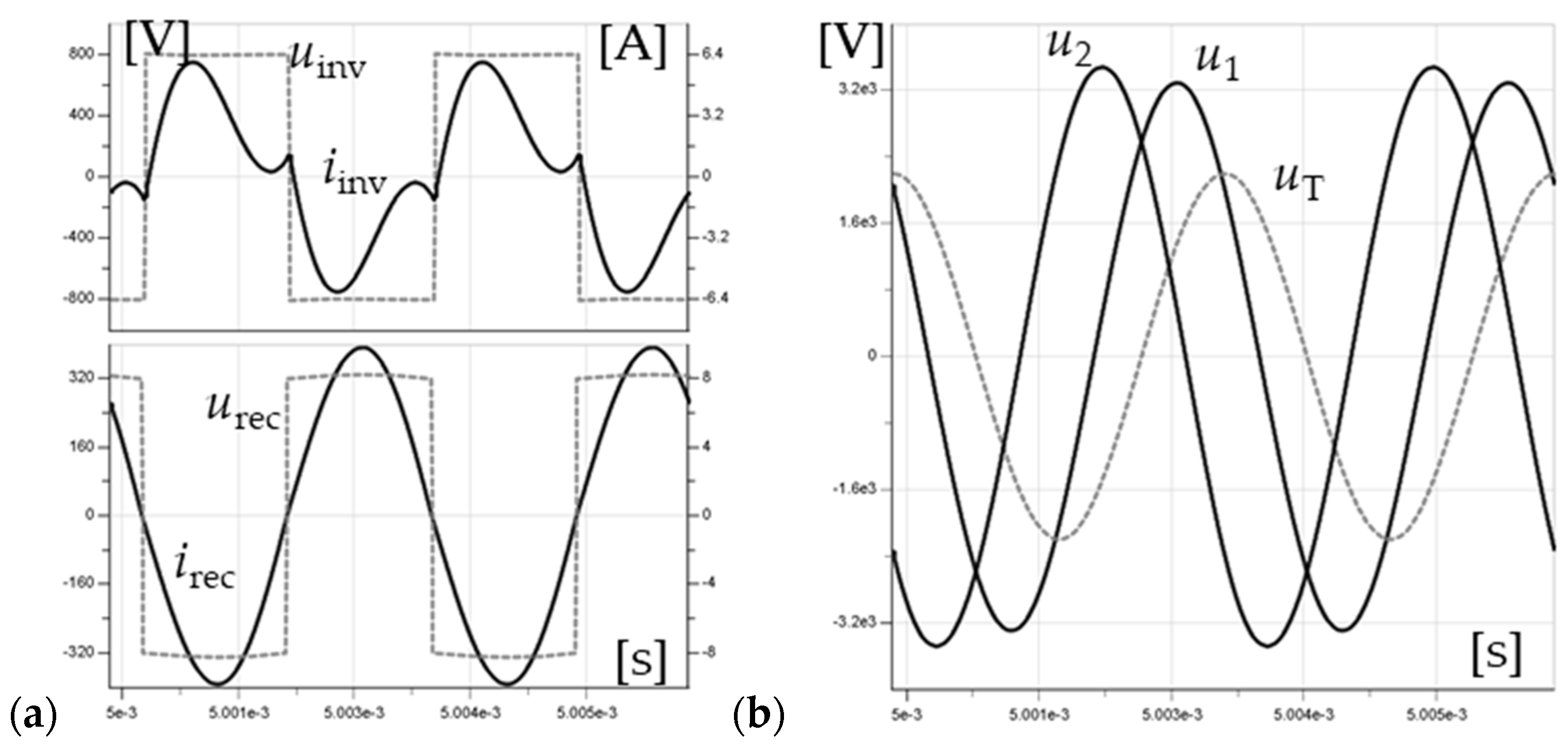
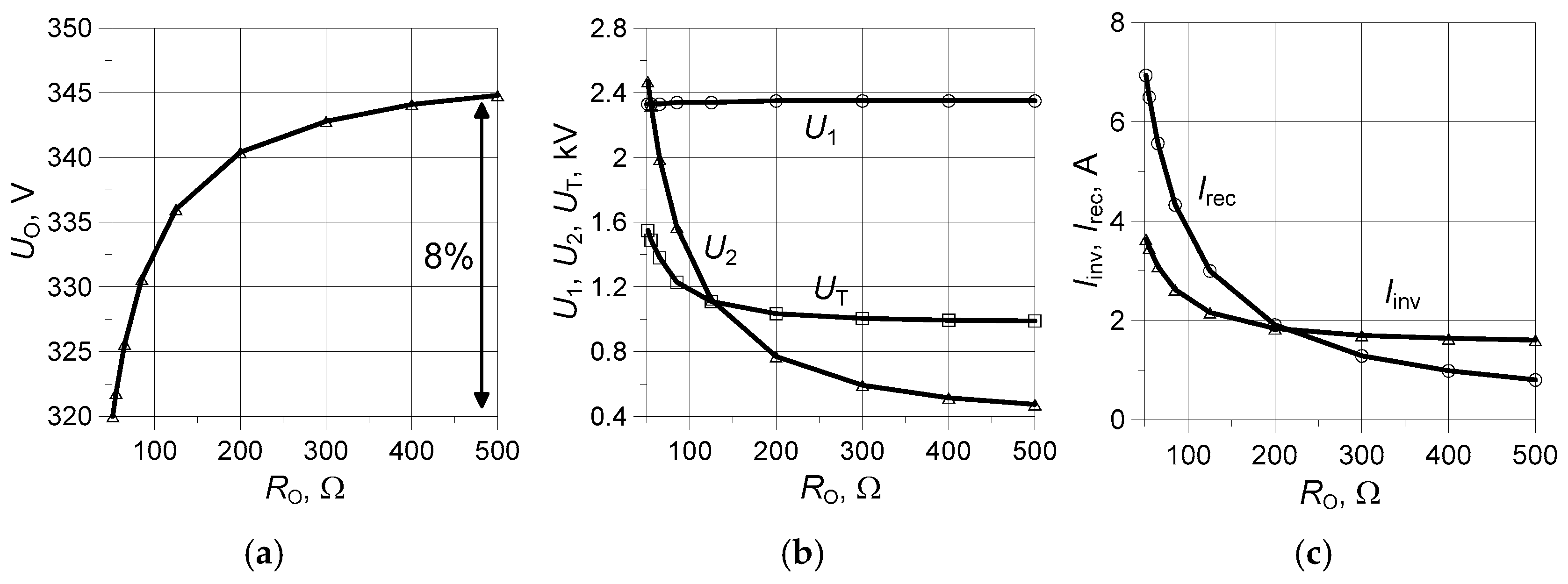
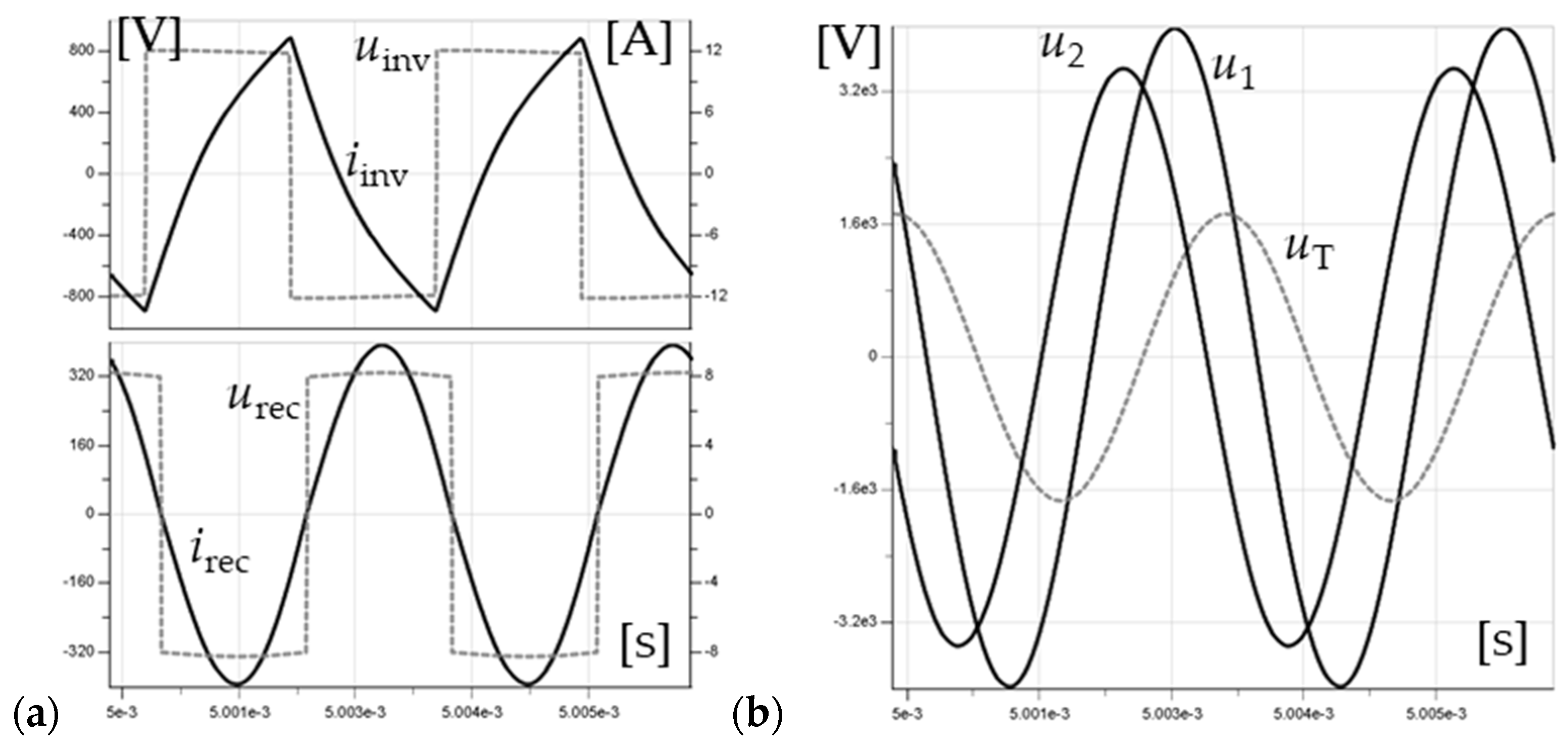
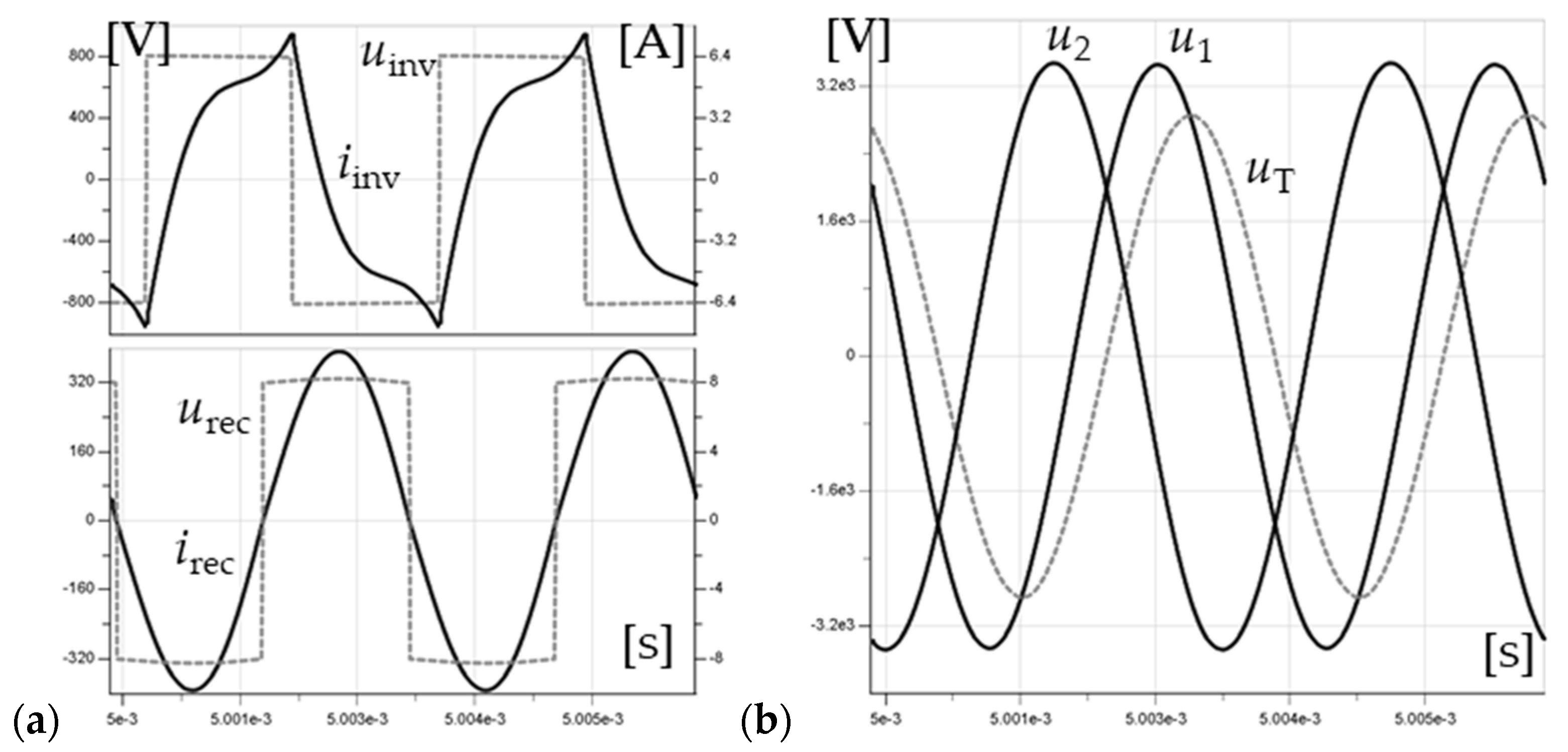


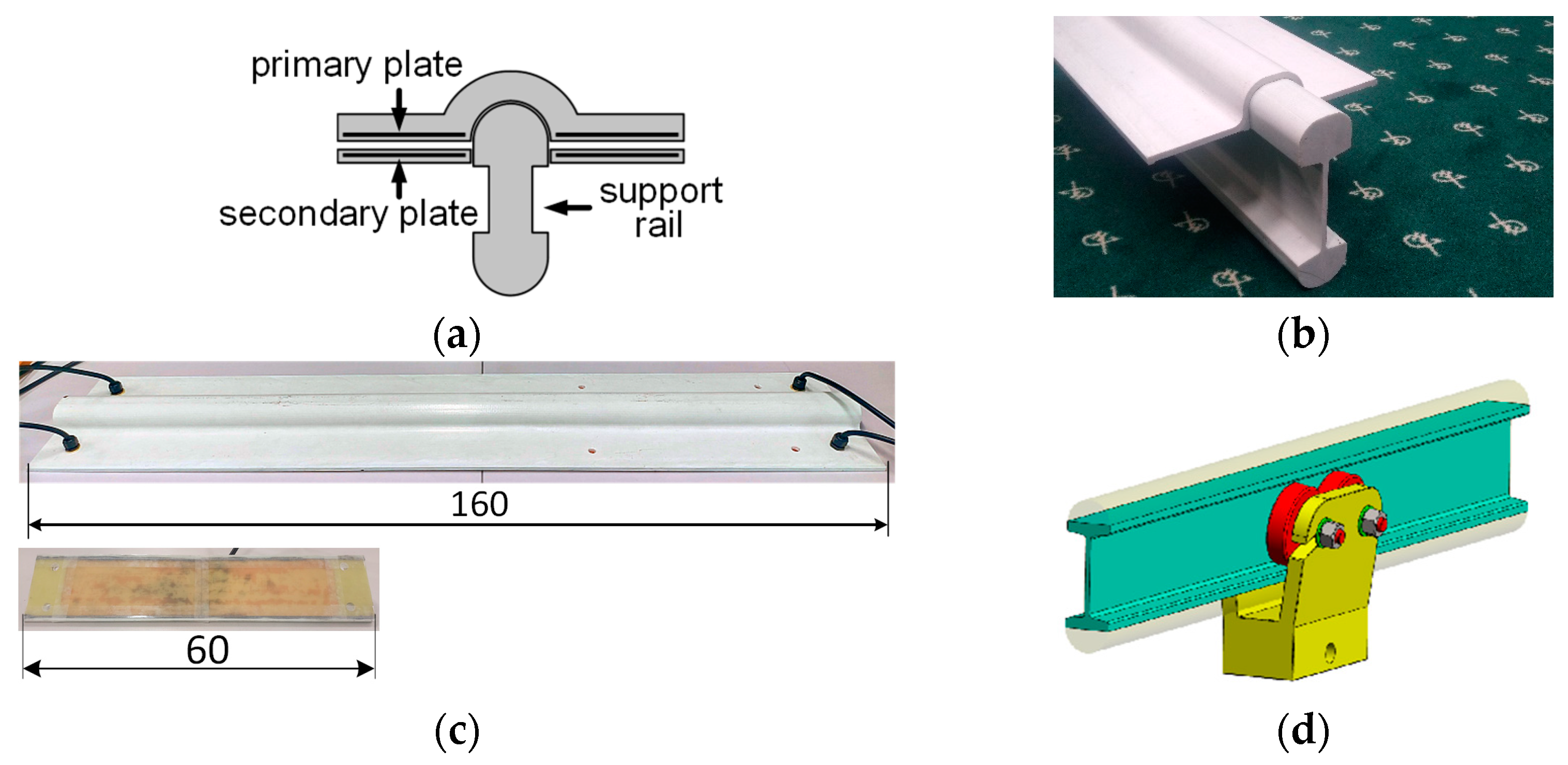
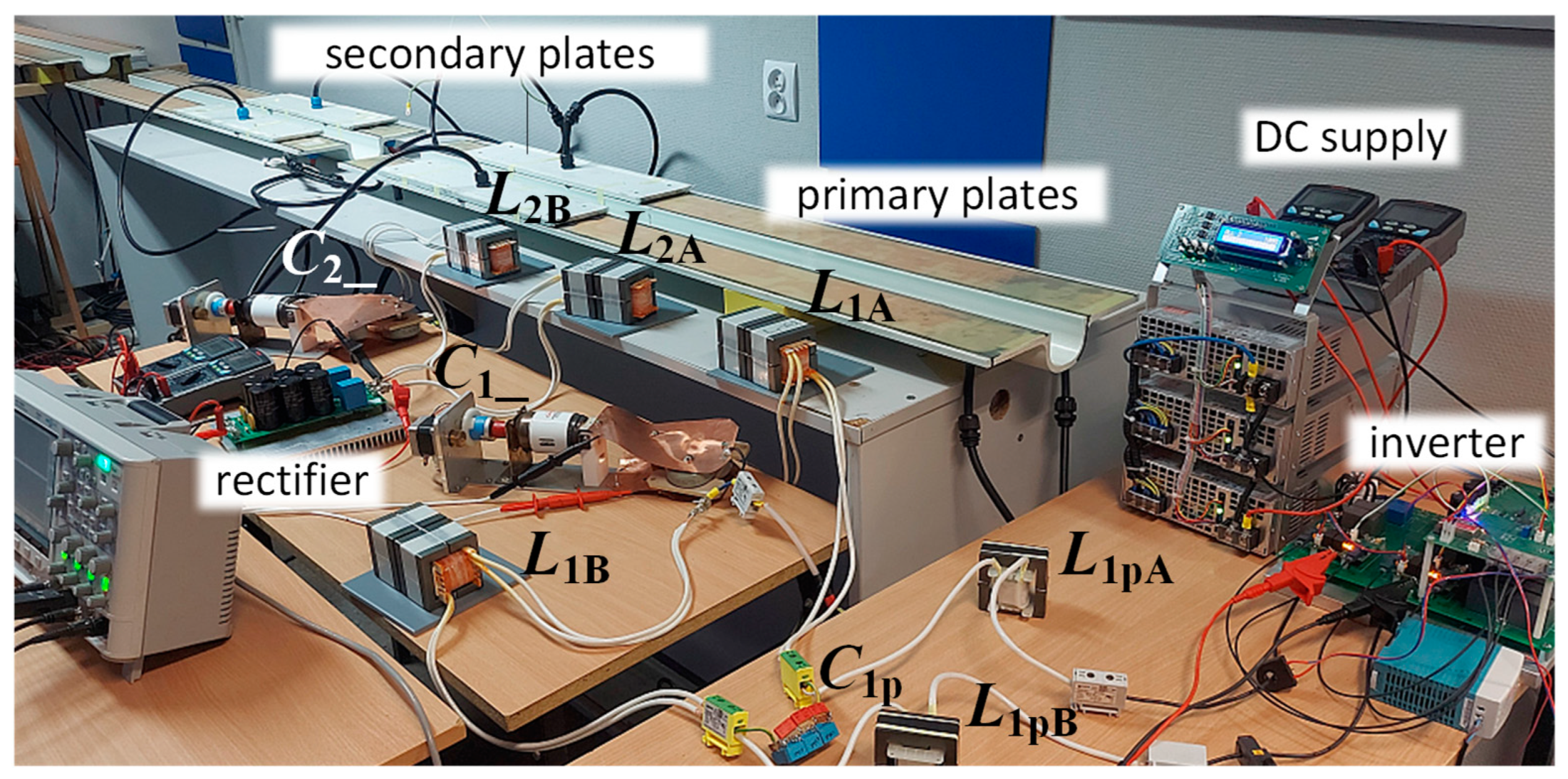

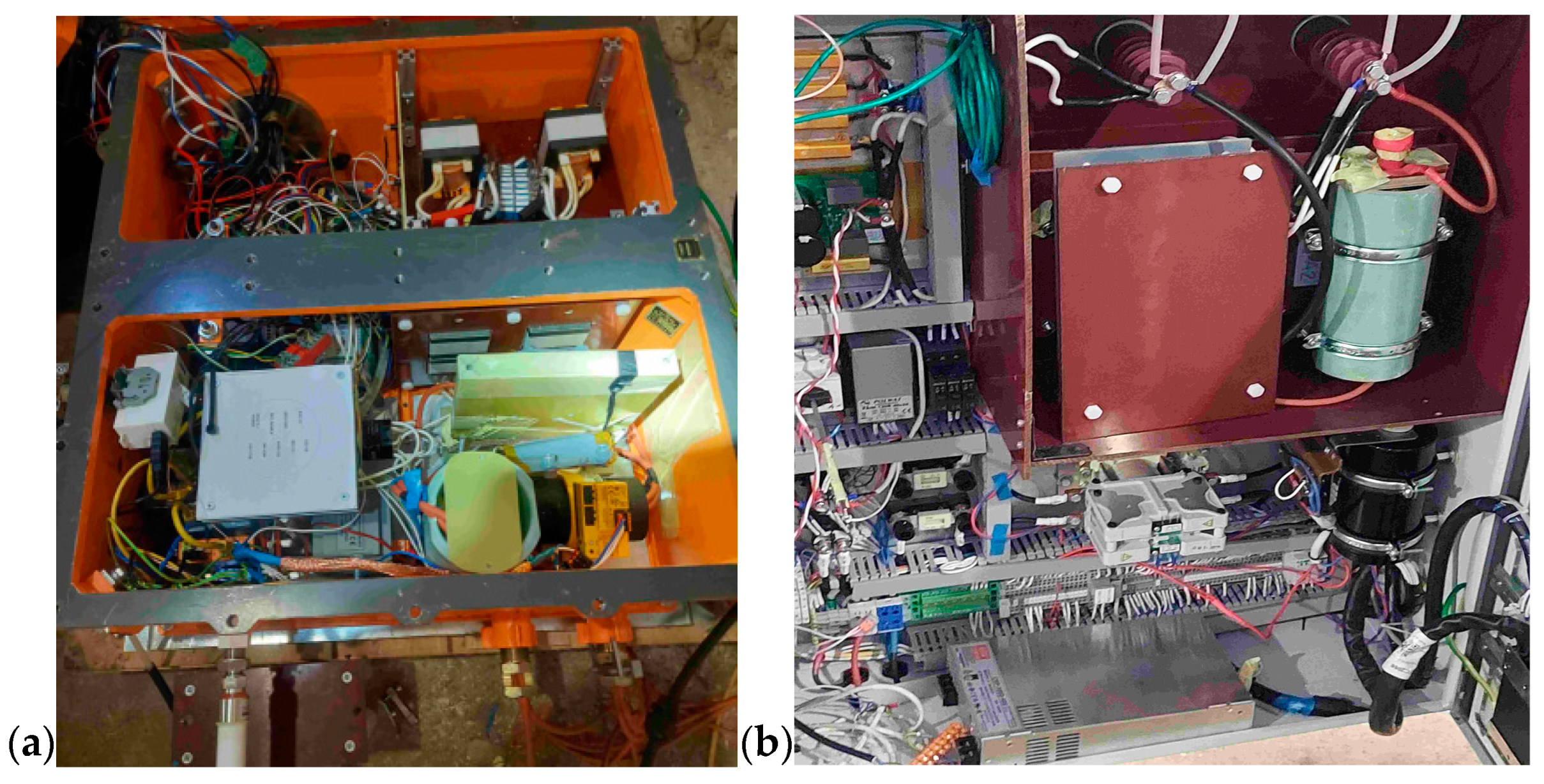
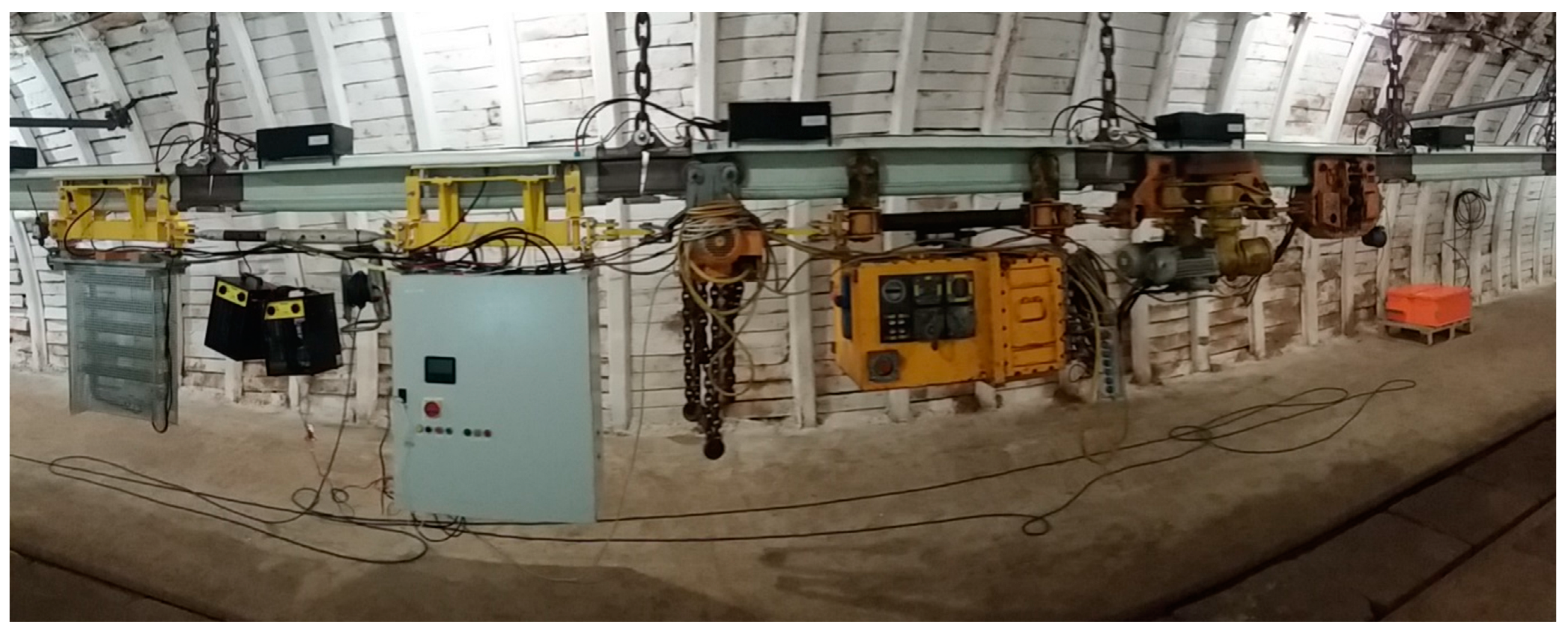
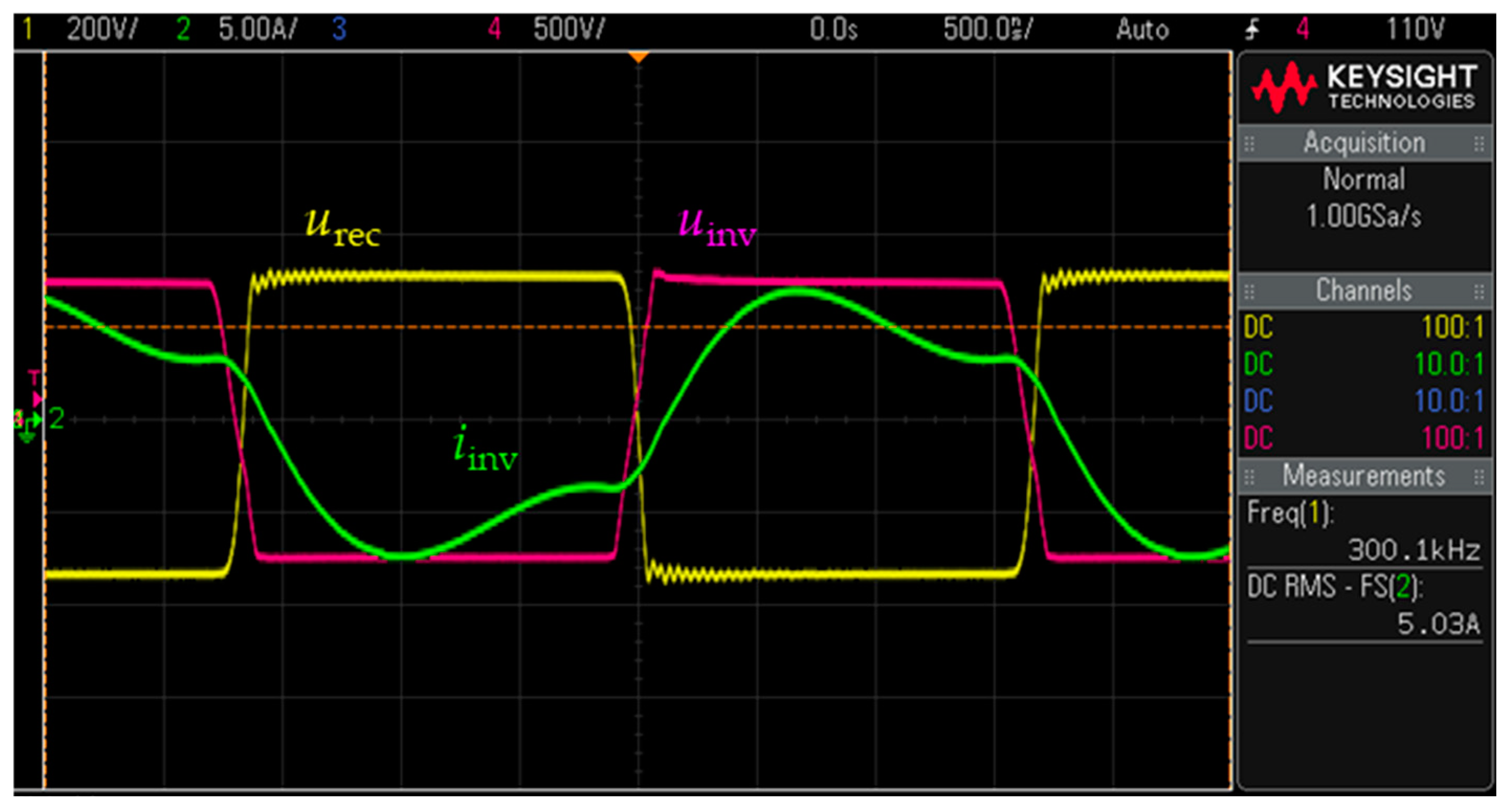


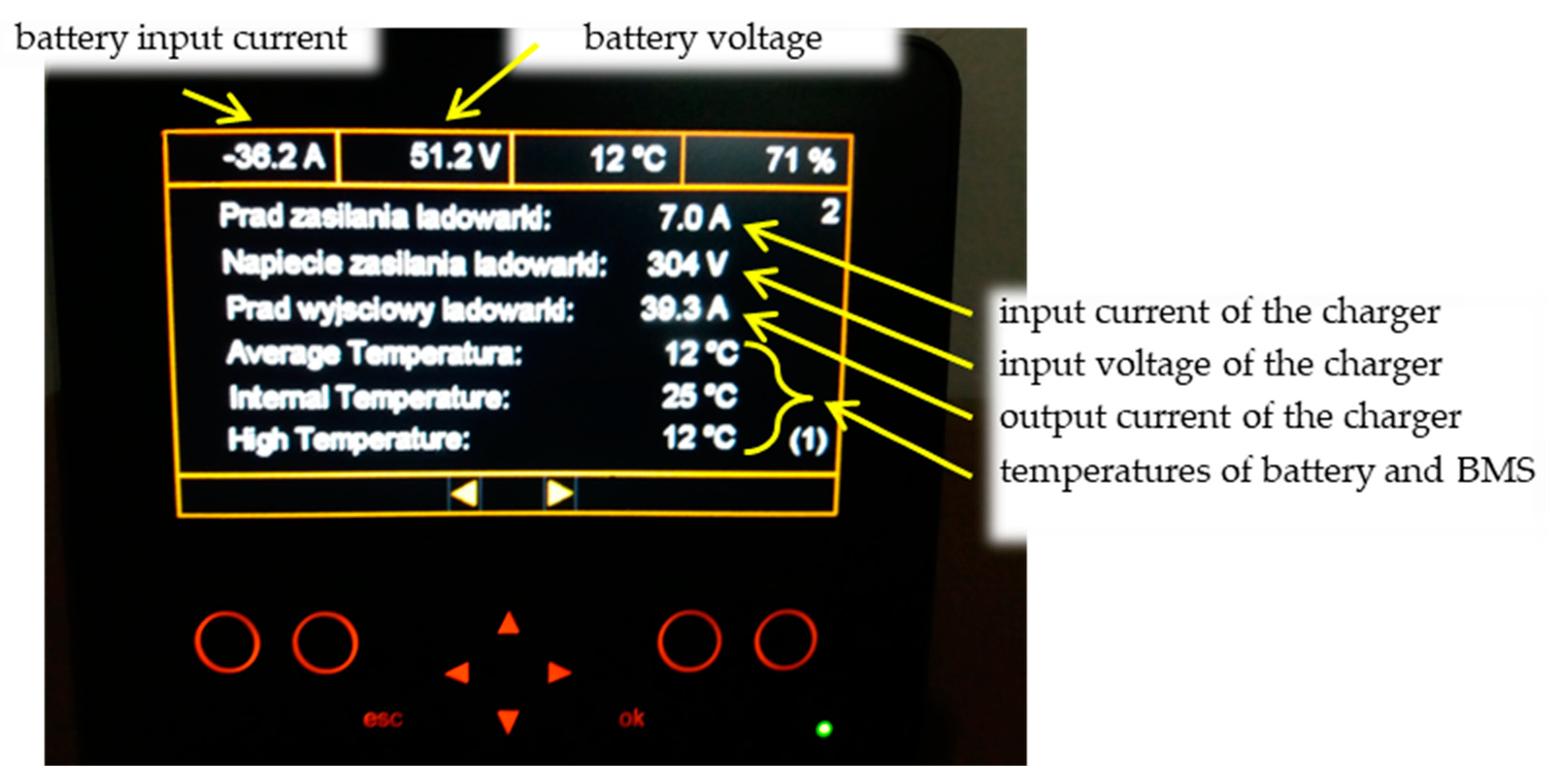
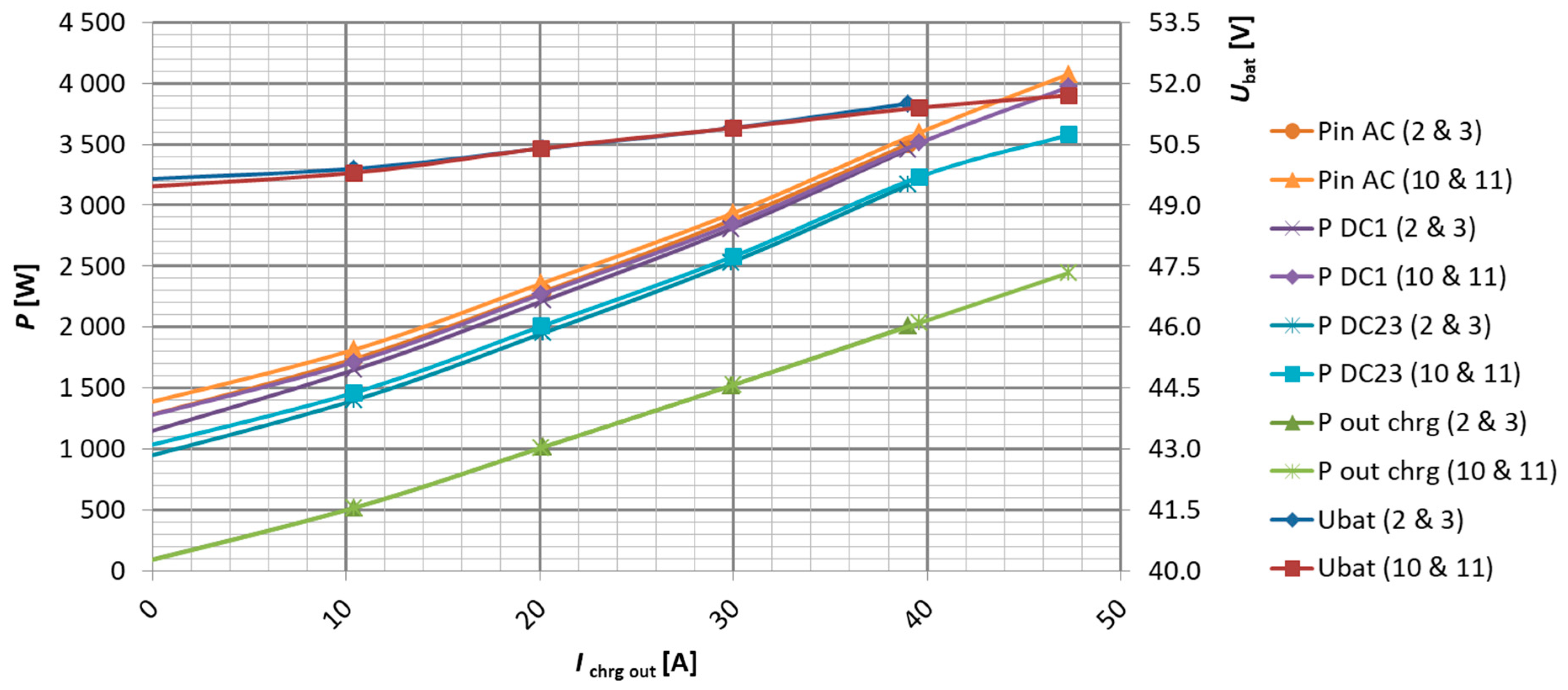
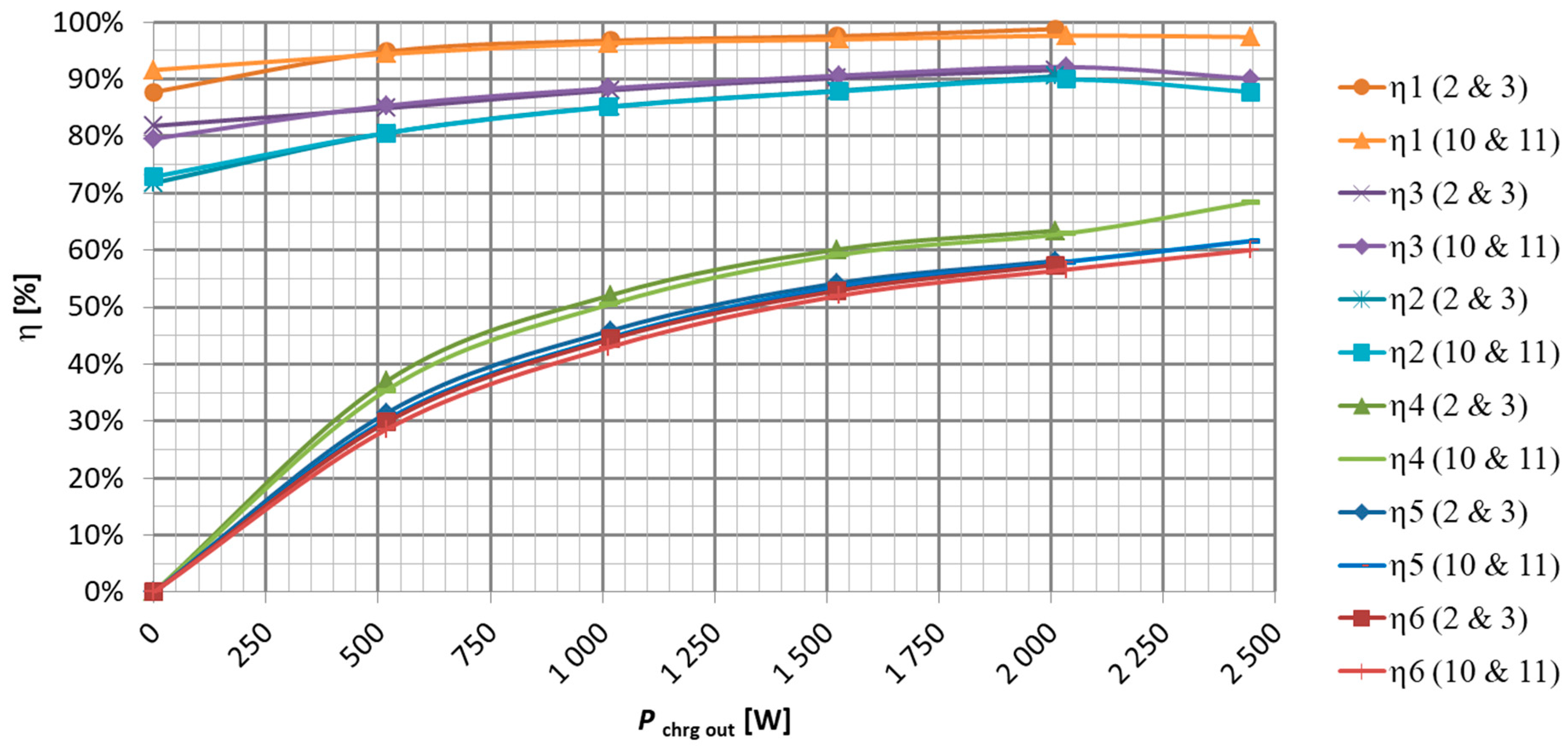
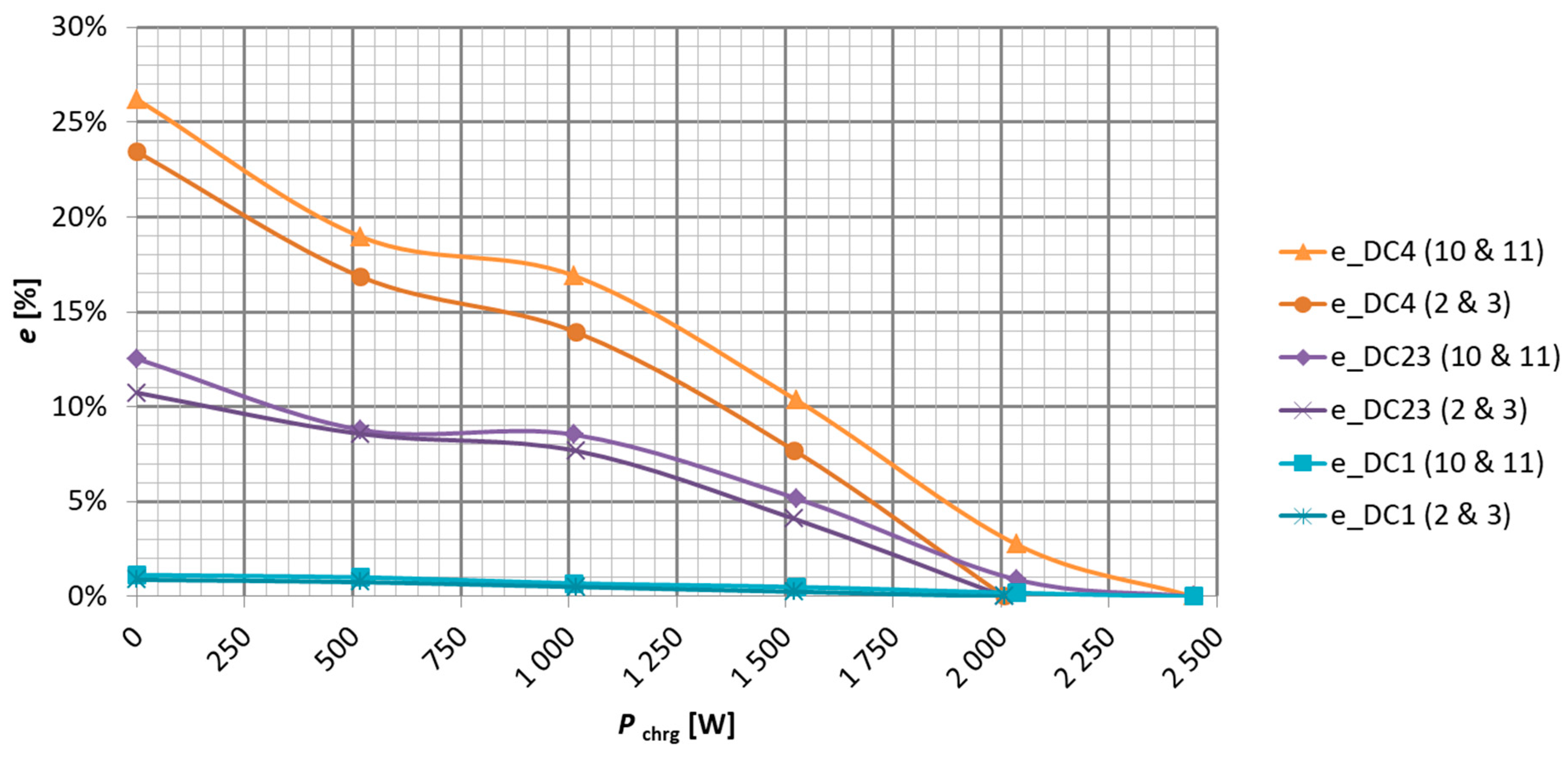
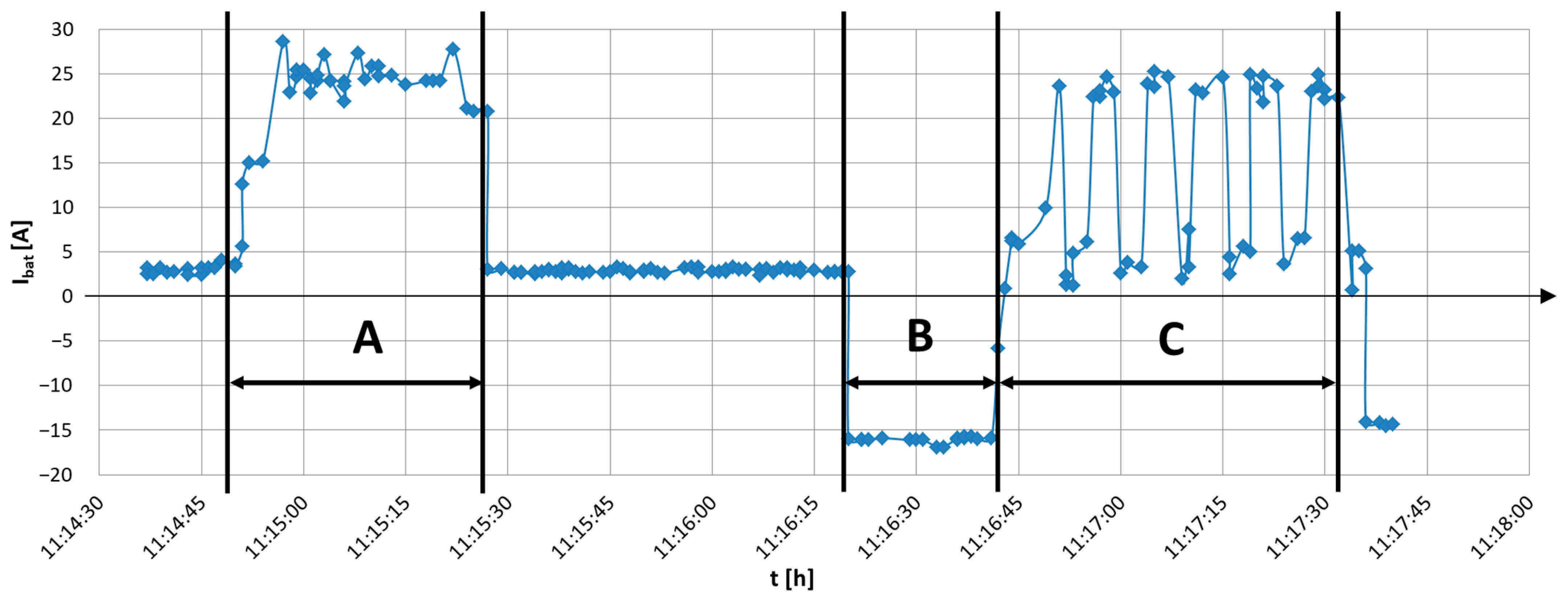

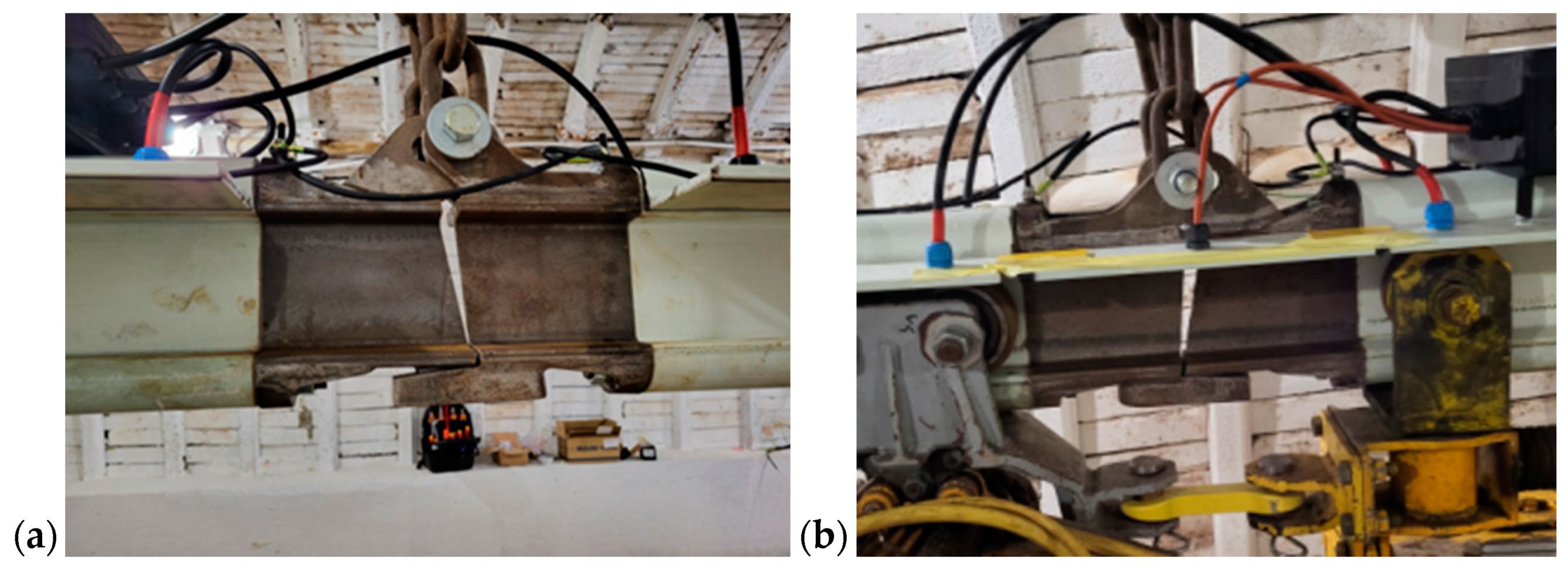
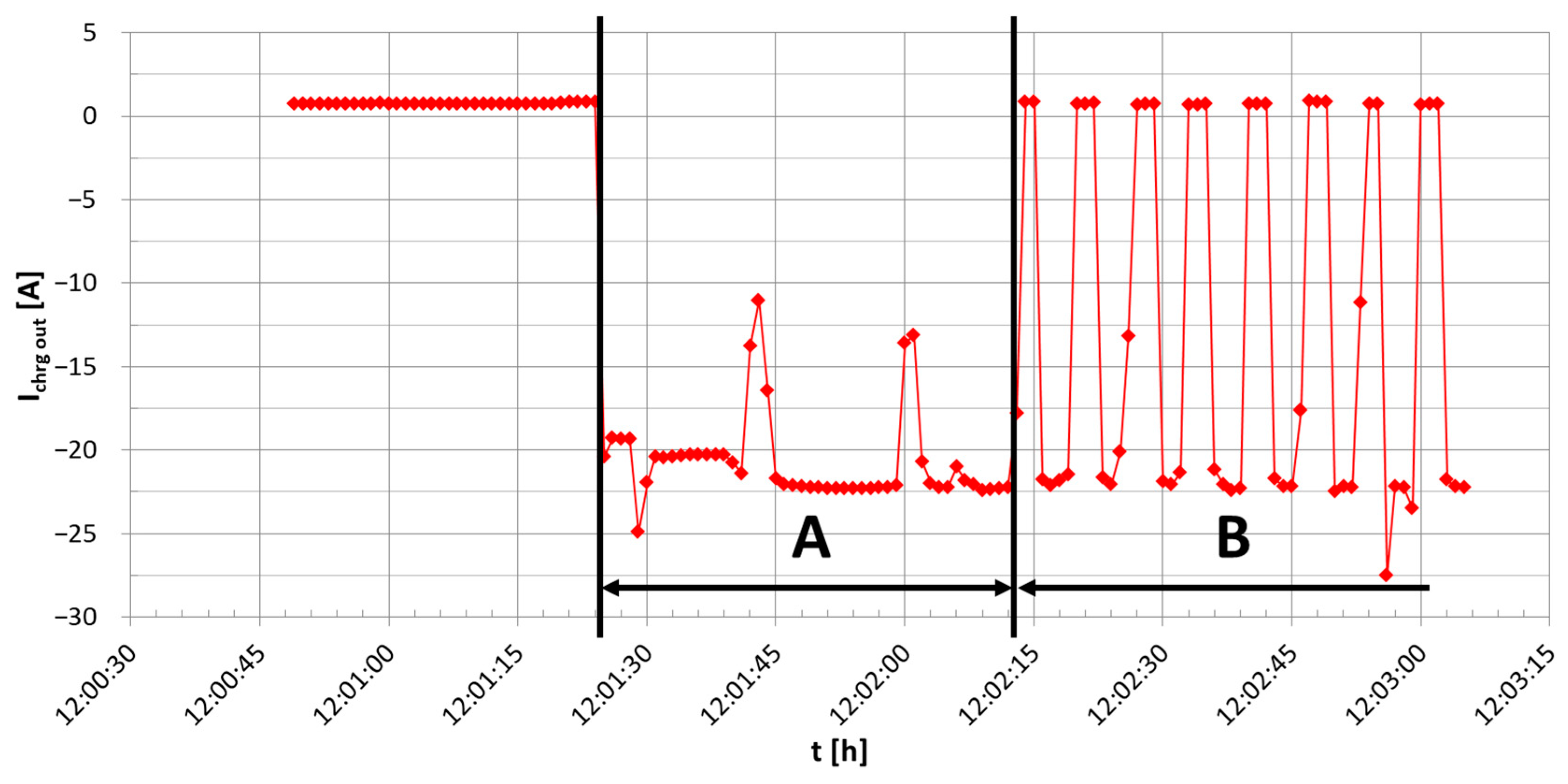
| Capacitance | Value [pF] |
|---|---|
| CC | 1755 |
| CE | 1656 |
| CF | 2460 |
| Parameter | Value | Unit |
|---|---|---|
| CP | 1554 | pF |
| CT | 402 | pF |
| CS | 102 | pF |
| L1pA | 22.6 | µH |
| L1pB | 23.3 | µH |
| C1p | 6.11 | nF |
| L1A | 93.0 | µH |
| L1B | 93.6 | µH |
| C1_ | 120 * | pF |
| C2_ | 1.2 * | nF |
| L2A | 93.5 | µH |
| L2B | 93.0 | µH |
Disclaimer/Publisher’s Note: The statements, opinions and data contained in all publications are solely those of the individual author(s) and contributor(s) and not of MDPI and/or the editor(s). MDPI and/or the editor(s) disclaim responsibility for any injury to people or property resulting from any ideas, methods, instructions or products referred to in the content. |
© 2025 by the authors. Licensee MDPI, Basel, Switzerland. This article is an open access article distributed under the terms and conditions of the Creative Commons Attribution (CC BY) license (https://creativecommons.org/licenses/by/4.0/).
Share and Cite
Skóra, M.; Rogala-Rojek, J.; Jendrysik, S.; Stankiewicz, K.; Polnik, B.; Kaczmarczyk, Z.; Kasprzak, M.; Lasek, P.; Przybyła, K. Innovative Capacitive Wireless Power System for Machines and Devices. Energies 2025, 18, 521. https://doi.org/10.3390/en18030521
Skóra M, Rogala-Rojek J, Jendrysik S, Stankiewicz K, Polnik B, Kaczmarczyk Z, Kasprzak M, Lasek P, Przybyła K. Innovative Capacitive Wireless Power System for Machines and Devices. Energies. 2025; 18(3):521. https://doi.org/10.3390/en18030521
Chicago/Turabian StyleSkóra, Marcin, Joanna Rogala-Rojek, Sebastian Jendrysik, Krzysztof Stankiewicz, Bartosz Polnik, Zbigniew Kaczmarczyk, Marcin Kasprzak, Paweł Lasek, and Krzysztof Przybyła. 2025. "Innovative Capacitive Wireless Power System for Machines and Devices" Energies 18, no. 3: 521. https://doi.org/10.3390/en18030521
APA StyleSkóra, M., Rogala-Rojek, J., Jendrysik, S., Stankiewicz, K., Polnik, B., Kaczmarczyk, Z., Kasprzak, M., Lasek, P., & Przybyła, K. (2025). Innovative Capacitive Wireless Power System for Machines and Devices. Energies, 18(3), 521. https://doi.org/10.3390/en18030521







